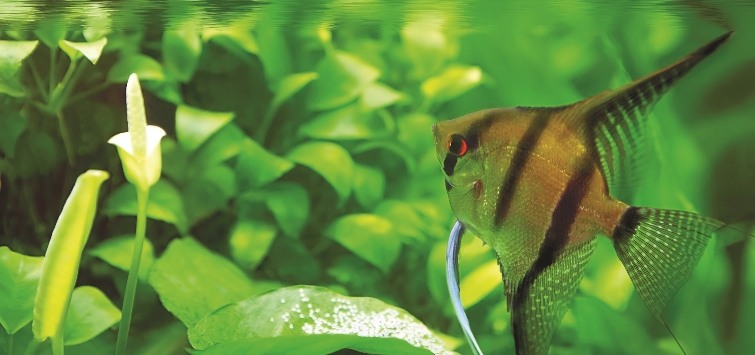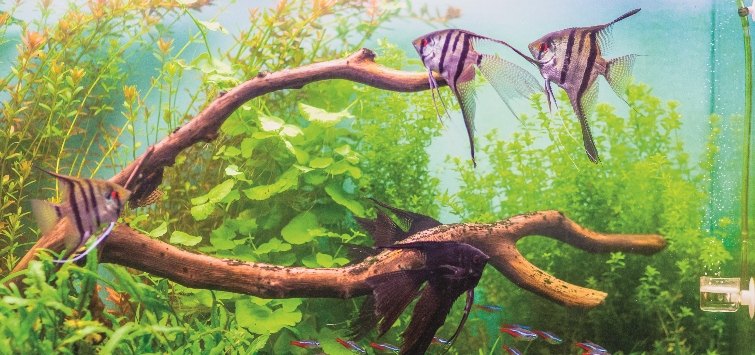How to Set Up an Angelfish Planted Tank
Lea Maddocks
Angelfish (Pterophyllum spp.) are among the most iconic tropical freshwater fishes, beloved by many aquarists. They are large, elegant, and full of personality, and with their distinctive shape and swimming style, they are mesmerizing and relaxing to watch swanning about any aquarium, especially well-planted tanks. They’re also generally hardy fish, and because they behave so well in a planted tank, angels can be great for beginners to the planted tank world who have a medium- or large-sized aquarium.Usually peaceful with fish that are not too small to be eaten, they’re a good choice for a community stocking scheme. Some can display aggression, but a good planting strategy will help in that regard.
If you are looking for a feature species for a planted tank, angelfish are a fantastic choice. The key is to find aquatic plants that are most suited to angels, and how to use them to best showcase and accommodate these regal fish. Follow our advice to set up a beautiful angelfish planted tank!
Angels of the Amazon
Angelfishes are members of the cichlid family. Angels originate from South America in the still, highly vegetated waters of the Amazon basin, including the countries of Peru, Colombia, Brazil, Guyana, and French Guyana. Their shoals tend to be large, with fish swimming among aquatic and submerged vegetation in slow-moving sections of river, tributaries, flood plains, and swamps.As carnivorous fish, the bulk of angels’ wild diet features aquatic insects, other invertebrates, and small fishes. They will also eat fry that are small enough to fit into their mouths. Within these swampy areas the fish will breed. In the wild, they favor plants with long stems or large leaves to lay eggs on and will show the high degree of parental care for which the family Cichlidae is famous.
Given this background, an angelfish planted tank environment should provide dense vegetative cover, including tall plants for them to swim among, explore, and take shelter from other fish. It should have a slow to moderate water flow, as angels are gentle swimmers and thus not appreciative of strong currents.
Adequate height and space to swim is also important so these tall-bodied fish can stretch their fins. Angels naturally move up and down while cruising through their surroundings. A 30-inch (76-cm) or larger tank with standard height will suffice, but taller is even better.
Angelfish are inquisitive, and defensive of their territories, especially when spawning, so you might want to create separate territories and break up lines of sight between them and other fish. This will reduce chasing by aggressive tankmates and help to keep the peace, especially if you have a breeding pair or are keeping multiple pairs. Note that if you have more than one pair, you should have at least a 48-inch (120-cm) tank to reduce the likelihood of fighting, and even more planting with an eye toward maintaining territories and breaking up lines of sight.
Planting for Angels

Angels are very tall-bodied, reaching up to about 10 inches (25 cm) from the tip of the anal fin to the tip of the dorsal fin. They’re also thin and can easily swim between plants and hardscape. This means that planting can be as dense as you like without the likelihood of it being damaged by their swimming activity, so you can have your cake and eat it too in terms of having large feature fish and delicate plants, as well as providing cover for the rest of your community fish.
The angelfish tank should be dominated by large-leaved plants, such as Java fern (Microsorum pteropus), Bolbitis heudelotii, Anubias spp., and especially Amazon swords (Echinodorus spp.), the latter of which are found in the angels’ natural habitats.
With some luck, they will choose these plants as a spawning site. Angels prefer large, sloping leaves to lay eggs on, so those types of plants will encourage natural spawning and breeding. Extra foliage (both large and fine) will also help to shelter fry; though the adults will usually give some parental care, extra cover is always recommended. Large-leaved plants make good features and focal points in an aquascape, with one or several in separate clumps.
For variety and to break sight lines, other long-stemmed plants can be used. Some hardy options for foliage and color contrast are fluffy-leaved Myriophyllum spp., Cabomba aquatica, large fern-leaved Ceratopteris thalictroides, small round-leaved Bacopa spp., long jungle-like Vallisneria americana, and Hygrophila spp., which are particularly useful and easy to care for.
If available, large-leaved H. corymbosa can also be used as a feature and spawning aquarium plant. For some hardy red/pinks, try including Ludwigia repens, L. arcuata x repens, and Rotala wallichii, which can also form tall, lush stands that complement greens.
Floating plants are terrific cover for angelfish tanks and can balance out the greenery below, especially in a tall tank if plants don’t quite reach the top where angels like to cruise. I favor hornwort (Ceratophyllum demersum) for this, as it adds a jungle-like effect, is terrific for cover and fry, and can be tucked or tangled around aquarium driftwood without planting. It’s also great for absorbing nitrates. For contrast, try some ruffled or clover-like Hydrocotyle spp. or fern-leaved Ceratopteris thalictroides, which can also be effective when left to float, especially with long roots trailing into the tank.
For the ground, stands of Cryptocoryne spp., including C. affinis, C. aponogetifolia, C. crispatula var. balansae, C. wendtii, C. beckettii, C. walkeri, and C. undulata look great and pair well with the taller plants, as many grow to medium height as they spread. As they are good in low light, they will thrive in shadows beneath the taller plants used in many angel tanks, as well as in especially tall tanks where the light source may be some distance from the bottom. Almost any plant works for angels, but these are some good starters that will add some interest and match an angel tank well, as they really showcase these fish.
Angelic Hardscape

Along with your plants, consider using some strategic hardscaping for your angelfish tank. Tall branches of driftwood and/or long, large stones (e.g., slate or thinner basalt slabs) add height and contrast to the vegetation. Having these stretching into the mid to upper sections will keep the eye traveling upward to where the angel action will be, and they can tie the lower and upper sections together well. Try angling the branches in the same direction to create a sense of water flow, or let them radiate out in separate directions for a wilder look.
Keeping the contrast of vegetation and hardscape up through the tank where the fish swim will create a natural-looking backdrop to truly showcase your angelfish. After defining your layout with hardscape, be sure to maintain some negative space among the stands of plants. This will add some balance to the scene and encourage the fish to swim from one stand to the next through the open water, creating a great effect and showing off the fish as they cruise across the open water.
Given the preference of angelfish for still or slow-moving water, and the fact that they do not do well in strong currents, I would recommend avoiding powerheads. However, a spray bar attachment or other way to diffuse the flow will allow them to do their work without bothering the fish. Turning down the flow is also an option.
Bringing Out Their Best
Anything but common, the beautiful angelfishes are a cornerstone of the hobby for obvious reasons. They are hardy and personable, with an iconic shape that makes them an elegant and easy choice for hobbyists from beginner to advanced, given an angelfish planted tank properly set up to meet their needs.When combined with lush planting to bring out their natural looks and behaviors, angels really are some of the most impressive tropical freshwater fish to behold. Tropical aquatic plants and angelfish are made for each other, and it can be easy, with a little planning, to have them complementing each other’s graceful beauty in a planted aquarium.

.png?h=595&iar=0&w=2781&hash=5FD5E69473BCC22199FBFA2FB71B6033)



